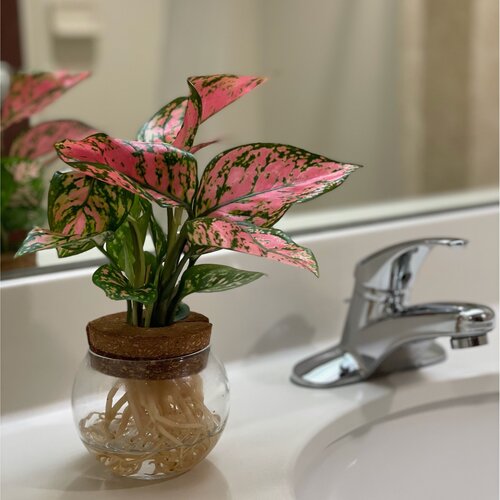The Ultimate Guide to Growing Chinese Evergreen
Add exotic appeal to indoor spaces with this stunning houseplant
 Check here to see if your Local Garden Center or The Home Depot® is carrying leafjoy®.
Check here to see if your Local Garden Center or The Home Depot® is carrying leafjoy®.
Chinese evergreen, also known as Aglaonema, is a common tropical houseplant valued for its lush, decorative foliage and forgiving nature, making it a good choice for beginners. The highly attractive leaves come in an array of colors, from deep green to shimmering silver, as well as shades of pink and red. The patterned foliage can be intricately splotched, striped or veined, with varieties to complement any style of indoor decor.
Aglaonema is one of the best houseplants for filtering out harmful air toxins, helping to create a healthier indoor environment. In Asian cultures, Chinese evergreen is thought to bring good luck, making it a popular housewarming gift. Plants are toxic and should be kept out of the reach of curious children and pets. Here’s how to grow this gorgeous houseplant and display it in your home or office.
CHINESE EVERGREEN CARE & PLANTING
Pot selection: Aglaonema prefers to be slightly root bound, but if the pot is too snug, it’s time to replant. When selecting a new pot, choose one that is 1- to 2-inches larger in diameter and slightly deeper than the current pot to allow for healthy root growth. If reusing an old container, clean and sterilize it to prevent potential disease or pest issues. Ensure the pot has adequate drainage holes to allow excess water to escape, preventing root rot and maintaining proper soil moisture levels.
How to plant: As part of Aglaonema care, plants will need repotting in fresh soil every 2 to 3 years. The best time to repot is during the spring and summer when plants are actively growing.
- Remove the plant from its pot.
- Inspect the root ball for any signs of rot or other damage.
- Cut out sections that are damaged, dead or mushy.
- This is a good time to check plants for any pest or disease problems.
- Place fresh potting soil in the bottom of the pot.
- Position the plant at the same level it was in the previous container.
- Add potting mix up to the base of the plant.
- Press down gently to firm the soil and remove air pockets.
- Water the plant slowly until liquid comes out of the bottom of the pot.
Light requirements: This adaptable indoor plant is tolerant of different light levels. Varieties with green leaves can tolerate low light, while variegated cultivars will do best in medium indirect light to retain the vivid coloring. Avoid direct sunlight, which can cause foliage to burn.
See a list of 14 Low-Light Houseplants
Temperature: Chinese evergreen plant is sensitive to cold, preferring warm temperatures between 65 to 80 degrees F. Temperatures below 60 degrees will cause stress and cold damage. Keep plants away from drafts, cooling and heating vents.
Humidity: These tropical plants prefer high-humidity levels as found in their native jungle habitat, but are tolerant of average indoor humidity. To increase the humidity level around plants, use a room humidifier, mist the leaves, or place plants on a tray with pebbles and water. Don’t allow the bottom of the pot to sit in water, as this can cause root rot.
Soil: Aglaonema plant prefers rich, well-draining soil. The best soil is a high-quality all-purpose potting mix, with orchid bark and perlite added to improve drainage.
Watering: For a Chinese evergreen houseplant, allow the soil to dry out in between waterings. Stick a finger into the top inch or two of soil, if it feels dry, it’s time to water. Avoid overwatering to prevent root rot and other diseases. During the growing season, water every 7 to 10 days. Reduce watering during winter.
Fertilizing: During spring and summer when Chinese evergreen plants are actively growing, feed once a month with an all-purpose liquid plant fertilizer. Cease fertilizing in fall and winter when plants are semi-dormant. Learn more about fertilizing houseplants.
Pruning: Trim off any yellow, brown or damaged foliage as it occurs. Chinese evergreen produces sap that can cause skin irritation. Wear rubber gloves when pruning and avoid getting the sap in your eyes, nose or mouth.
TRY THESE PROVEN WINNERS® LEAFJOY® VARIETIES
|
|
|
Igneous™ Glitter Glamour™ (Aglaonema x) features large lance-shaped dark-green leaves with wide bands of silver variegation that radiate from the midrib and marbling along the outer margins. This cultivar is tolerant of low light and can grow larger than other varieties, making it suitable as a showy floor specimen. |
Igneous™ Timeless Tides™ (Aglaonema commutatum) has timeless elegance, with sword-shaped leaves adorned with mottled silver patterns and splashes of dark green along the veins and margins. Display this lush variety on a plant stand or end table. |
Igneous™ Crystal Vision™ (Aglaonema x) boasts long lanceolate leaves of emerald green with silvery-white V-shaped bands that emanate from the midrib for striking contrast. Display by itself or alongside other houseplants on a desktop or table as an elegant accent. |
CHINESE EVERGREEN FAQS
Where is the best place to put Aglaonema?
Place Aglaenoma plants near an east-facing window that receives low to medium indirect light. Avoid drafts and extreme temperature fluctuations, which can cause plant stress.
Is Aglaonema good inside the house?
Aglaonema is native to tropical regions of Asia, preferring warm temperatures, high humidity and indirect light. Plants are adaptable to indoor growing environments.
Can I keep Aglaonema outside?
Aglaonema is a tropical plant that won’t survive outdoors in colder climates. Plants can be moved outside during warmer months when nighttime temperatures are consistently 60 degrees F or above. Place in a shady spot that receives bright indirect light.
Does Chinese evergreen need sunlight?
In its native habitat, Chinese evergreen thrives in tropical forests underneath dense tree canopies. Direct sunlight may burn the leaves.
How big will a Chinese evergreen get?
This slow-growing houseplant will stay smaller when grown indoors. Some varieties may grow larger, becoming suitable as floor specimens. These compact upright plants can reach 1 to 3 feet tall and wide.
Why are my Chinese evergreen leaves turning yellow?
There are several reasons why Chinese evergreen has yellow leaves, including overwatering, underwatering, or too much direct sunlight. It can also indicate a deficiency of copper or other nutrients. Keep plants watered and fertilized regularly to prevent problems.
What does an overwatered Chinese evergreen look like?
Overwatering can cause root rot or other diseases. Symptoms may include yellow, wilted, curled or dropped leaves. Remove the affected plant from its pot and inspect the roots. Cut out any damaged, mushy or dead roots and rinse to remove old soil. Treat with a fungicide as needed and repot in fresh soil. To prevent problems, reduce watering and make sure the bottom of the pot is not sitting in standing water.
HOW TO USE CHINESE EVERGREEN IN YOUR HOME OR OFFICE
Try some of these ideas for displaying Chinese evergreen in your indoor spaces:
- Choose several different varieties of Aglaenoma and plant them in matching or complementary decorative pots. Place together on a sideboard or shelf for a striking display.
- Where space is at a premium, use a plant hanger or hanging basket to display Chinese evergreen on a wall or from the ceiling.
- Place Aglaenoma on a mantelpiece alongside decorative accessories such as books, statuary and candles for an eclectic display.
- Adorn a bedroom nightstand or dresser with Chinese evergreen to create a healthier sleep environment. See more bedroom plants.
- Display Aglaenoma on a bathroom shelf or kitchen counter to take advantage of the higher humidity levels. Check out more plants in our leafjoy® SpaScene® Collection.
- Place an Aglaenoma in a colorful pot and use as a centerpiece on a dining room table.
- Liven up a living room coffee table with an Aglaenoma planted in a decorative container that matches the room decor.
- Larger plants can be displayed as floor specimens in a home or office.
- Group Chinese evergreen alongside other housplants with similar growing needs to boost air humidity and make maintenance chores more efficient.
- Brighten up a work environment by displaying a colorful Aglaenoma on a desktop or plant stand. Discover more plants for work spaces in our leafjoy® WorkLife™ Collection.
CHINESE EVERGREEN COMPANIONS
Display Chinese evergreen alongside other plants with similar growing needs of low to medium indirect light, high humidity and moderate moisture. Try some of these Aglaenoma companions:
- Austere Luster™ Superba snake plant
- Beautifall® Summer Nights™ pothos
- Urban Arches™ Pixie Punk™ spider plant
- Prismacolor™ Fall Leaves™ blushing philodendron
- Falling Arrows® Ruby Reign™ arrowhead vine
Want to learn more?
Best Indoor Plants for Beginners










